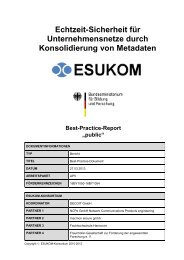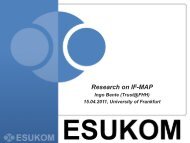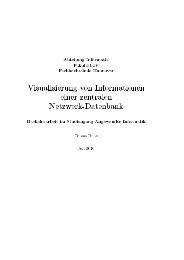Leveraging Trusted Network Connect for Secure ... - esukom
Leveraging Trusted Network Connect for Secure ... - esukom
Leveraging Trusted Network Connect for Secure ... - esukom
Create successful ePaper yourself
Turn your PDF publications into a flip-book with our unique Google optimized e-Paper software.
According to the requirements and the application scenarios of the pilot user<br />
SIMOIT realized a development and test plat<strong>for</strong>m, which evaluated the TNC<br />
methodology. The main plat<strong>for</strong>m is represented by the Mobile Security Gateway<br />
(MSG) as mentioned be<strong>for</strong>e. The project specifically evaluated open source software<br />
projects and methods with the aim to realize a standard solution. At the same time,<br />
SIMOIT paid high attention to flexibility, so that typical security components such as<br />
firewalls can be integrated as well. In this case, instead of using the SIMOIT module<br />
an interface was provided. Also, it was stipulated that existing inventory databases<br />
can be interconnected in order to retrieve software versions and patch levels. The pilot<br />
user required the interconnection of an Active Directory Server (ADS), which made it<br />
necessary to develop an interface via LDAP. Through this, all user profiles crucial <strong>for</strong><br />
authentication can be retrieved, and routed to the Mobile Security Gateway (MSG).<br />
For the sake of high flexibility, SIMOIT mainly focused on a server-side solution.<br />
The reason <strong>for</strong> this is the fact, that in the future mobile device vendors will provide<br />
their own access software. Hence, on the server side any TNC implementation can be<br />
customized.<br />
3.4 TNC@FHH<br />
The TNC@FHH approach (http://trust.in<strong>for</strong>m.fh-hannover.de) is also an open source<br />
implementation of the TNC architecture <strong>for</strong> integrity check of mobile devices. In<br />
order to enable an open and standardized implementation, open source software has<br />
been analyzed. As in the SIMOIT project the TNC@FHH approach allows integration<br />
of conventional security components such as firewall systems. A further precondition<br />
was to develop a framework based on the IEEE 802.1X standard in order to be used in<br />
Ethernet-based network environments.<br />
Fig. 3. TNC@FHH implementation.<br />
The realization of the project bases on two essential and separated software<br />
packages. On the client-side specific IMCs have been developed, which analyze and<br />
communicate the current security status of the systems. This critical in<strong>for</strong>mation is<br />
communicated to the IMV residing on the RADIUS/TNC server and validated against<br />
the security policy. After the evaluation has been accomplished and the mobile device<br />
meets the requirements, the RADIUS server sends an access-accept notification to the<br />
<strong>Network</strong> Access Server (IEEE 802.1X compatible switch or router), which then<br />
grants the client the respective network access.





